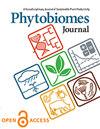Exploring microbial dysbiosis in orchards affected by little cherry disease
IF 3.3
3区 生物学
Q2 MICROBIOLOGY
引用次数: 0
Abstract
The phytoplasma Candidatus phytoplasma pruni (CPP), a causative agent of little cherry disease (LCD), has become an increasing problem for sweet cherry growers in Washington state, which is the largest producer of cherries in the USA. The control of LCD currently relies on the identification and removal of infected trees, which has proven to be difficult because of the prolonged asymptomatic, but still contagious state of the disease, and the lack of reliable and economical tests. Thus, the development of new approaches for early detection of LCD will be an important step in the successful control of this tree fruit disease. To identify potential microbial indicators of CPP infection we evaluated the bacterial and fungal communities in the roots of cherry trees from two different orchards that were: (i) infected with CPP and symptomatic; (ii) infected with CPP but remained asymptomatic; and (iii) healthy, non-CPP infected trees. We found significant variation in the microbiomes between the two cherry orchards, with the location being a stronger driving factor determining the fungal compared to the bacterial community. The fungal communities were less affected by the disease conditions compared to the bacterial microbiome. Overall, this study demonstrates feasibility of the microbiome approach for the early detection of LCD by CPP, but also demonstrates that more orchards need to be sampled as location was a stronger contributor to the microbiome of cherry tree roots than disease condition.探讨小樱桃病对果园微生物生态失调的影响
小樱桃病(LCD)的病原体Candidatus植原体pruni(CPP)已成为华盛顿州甜樱桃种植者日益严重的问题,华盛顿州是美国最大的樱桃生产国,但这种疾病仍然具有传染性,而且缺乏可靠和经济的检测。因此,开发早期检测LCD的新方法将是成功控制这种果树疾病的重要一步。为了确定CPP感染的潜在微生物指标,我们评估了来自两个不同果园的樱桃树根部的细菌和真菌群落:(i)感染CPP并有症状;(ii)感染CPP但仍无症状;以及(iii)健康的、未受CPP感染的树木。我们发现两个樱桃园之间的微生物组存在显著差异,与细菌群落相比,位置是决定真菌的更强驱动因素。与细菌微生物组相比,真菌群落受疾病条件的影响较小。总的来说,这项研究证明了微生物组方法用于CPP早期检测LCD的可行性,但也证明了需要对更多的果园进行采样,因为与疾病状况相比,位置对樱桃树根的微生物组的贡献更大。
本文章由计算机程序翻译,如有差异,请以英文原文为准。
求助全文
约1分钟内获得全文
求助全文

 求助内容:
求助内容: 应助结果提醒方式:
应助结果提醒方式:


